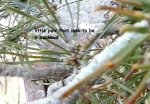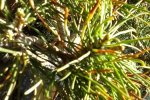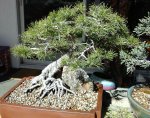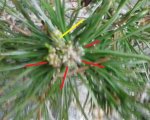Mike Corazzi
Masterpiece
I mean how, after picking out a tree some 15 years ago in an old nursery with no idea what the hell it was, did it end up being a SINGLE FLUSH ....Scots?
Then after giving it away and the recipient letting the FLOWER POT tip over and make exposed roots, how come when I found out was it a SCOTS pine?
Aaagh!
Now look at this article. I did.
https://crataegus.com/2016/04/14/big-difference-between-decandling-and-breaking-pine-shoots/
And I'm as confused as usual when it comes to THIS tree.
(please ignore the brown tips of the needles as it's the result of my COOKING the roots last summer THINKING that...SCOTS...pine would appreciate trillion degree ALL DAY sun to ...."strengthen" it.)
Oh, it is WAY better than last fall when the needles were gray and DROOPING!
So..... now to "decandling."
Here are some pix. Not the best. Maybe WAY not the best....but..... this is them.
From what YOU can discern from these crummy images, would YOU do ANYTHING to these baby candles?
EVER? Well, I don't mean, "EVER" but at least.....when?
If this is as unclear as the pix, pls reply with questions and I'll ....attempt.... to make some sense.
(oh, I will image your bonsai for a beer. or ...after...some beers)





Then after giving it away and the recipient letting the FLOWER POT tip over and make exposed roots, how come when I found out was it a SCOTS pine?
Aaagh!
Now look at this article. I did.
https://crataegus.com/2016/04/14/big-difference-between-decandling-and-breaking-pine-shoots/
And I'm as confused as usual when it comes to THIS tree.
(please ignore the brown tips of the needles as it's the result of my COOKING the roots last summer THINKING that...SCOTS...pine would appreciate trillion degree ALL DAY sun to ...."strengthen" it.)
Oh, it is WAY better than last fall when the needles were gray and DROOPING!
So..... now to "decandling."
Here are some pix. Not the best. Maybe WAY not the best....but..... this is them.
From what YOU can discern from these crummy images, would YOU do ANYTHING to these baby candles?
EVER? Well, I don't mean, "EVER" but at least.....when?
If this is as unclear as the pix, pls reply with questions and I'll ....attempt.... to make some sense.
(oh, I will image your bonsai for a beer. or ...after...some beers)








